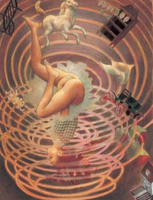
Back in May I blogged Lost Girls.
It is on the street now, and sexual guerilla Susie Bright has interviewed Alan Moore.
I have not yet received my copy of Lost Girls, but think it'll be worthwhile, or at least significant. Alan Moore has written a couple things I couldn't read, but he has never written anything poorly.
Me, I paid $150 for a special signed edition, partly because I am a big Alan Moore fan, and partly because I think classy erotica is a thing to fight for. There really is no reason almost all erotica/porn is dreadful, except the stigma attached to it, which scares away legitimate artists.
You can get the book for much less at Amazon though.
Salon has a good article/review about it. One of the good points from it is that while Alan claims this is porn, it probably works better as Art. Both the writing and the art is very stylized. I don't see many people getting excited by that. But maybe he is just trying to break down the rigid barriers our culture has between the two.
Update: Neil Gaiman agrees:
Starred Review. [Signature] Reviewed by Neil Gaiman
Almost 10 years before his The League of Extraordinary Gentlemen took many of the figures of Victorian popular fiction on a remarkable romp, Alan Moore, in collaboration with underground artist Melinda Gebbie, began Lost Girls, with a similar, although less fantastical, conceit: that the three women whose adventures in girlhood may have inspired respectively, Alice's Adventures in Wonderland, Peter Pan and Wendy and the Wizard of Oz, meet in a Swiss hotel shortly before the first World War. Wendy, Dorothy and Alice, three very different women—one jaded and old; one trapped in a frigid adulthood; the last a spunky but innocent young American good-time girl—provide each other with the liberation they need, while also providing very different (and, for this is a pornography, very sexual) versions of the stories we associate with them. We go with the girls, in memory, to the incidents that became the Rabbit Hole, Oz and Neverland. As a formal exercise in pure comics, Lost Girls is as good as anything Moore has written. (One of my favorite moments: a husband and wife trapped in a frozen, loveless, sexless relationship, conduct a stiff conversation, laced with unconscious puns and wordplay, moving into positions that cause their shadows to appear to copulate wildly, finding the physical passion that the people are denied.) In addition to being a master-class in comics technique, Lost Girls is also an education in Edwardian smut—Gebbie and Moore pastiche the pornography of the period, taking in everything from The Oyster to the Venus and Tannhauser period work of Aubrey BeardsleyMelinda Gebbie was a strange and inspired choice as collaborator for Moore. She draws real people, with none of the exaggerated bodies usual to superhero or porno comics. Gebbie's people, drawn for the most part in gentle crayons, have human bodies,.Lost Girls is a bittersweet, beautiful, exhaustive, problematic, occasionally exhausting work. It succeeded for me wonderfully as a true graphic novel. If it failed for me, it was as smut. The book, at least in large black-and-white photocopy form, was not a one-handed read. It was too heady and strange to appreciate or to experience on a visceral level. (Your mileage may vary; porn is, after all, personal.)Top Shelf has chosen to package it elegantly and expensively, presenting it to the world not as pornography, but as erotica. It is one of the tropes of pure pornography that events are without consequence. No babies, no STDs, no trauma, no memories best left unexamined. Lost Girls parts company from pure porn in precisely that place: it's all about consequences, not to mention war, music, love, lust, repression and memory. (Aug.)Neil Gaiman is the author of the bestsellers Anansi Boys and American Gods. Films based on his books Stardust and Coraline are due in 2007and 2008, respectively.
No comments:
Post a Comment